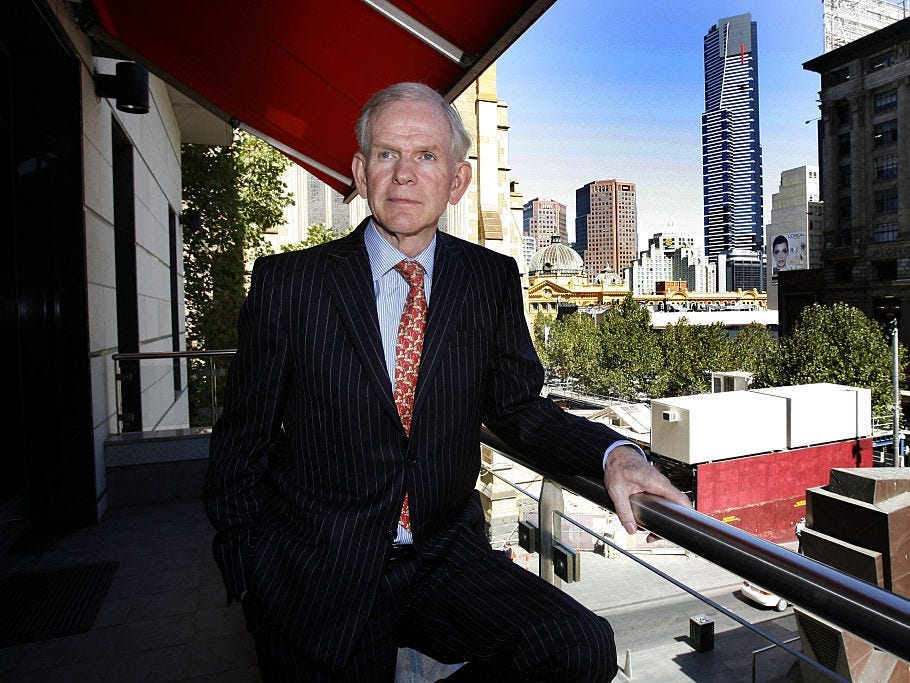- Investing titan Jeremy Grantham made prescient calls about the bursting of bubbles in 2000 and 2008.
- In an interview, he explained how the current market is eerily reminiscent of the dot-com bubble.
- He also shared the four indicators that have lined up for the biggest potential wipeout of value.
When Jeremy Grantham declared in January that “the long, long bull market since 2009 has finally matured into a fully fledged epic bubble,” he knew there would be “a substantial increase in crazy behavior” before it all came crashing down.
The co-founder of Boston-based Grantham, Mayo & van Otterloo is famous for having made prescient calls about the bursting of the 1989 Japanese asset price bubble, the 2000 tech bubble, and the 2008 real estate bubble.
“The thing about a bubble is if you can find more money and more crazy investors, it can keep going,” he told Insider.
As it played out, what Grantham saw in the fourth quarter as “extreme overvaluation, explosive price increases, frenzied issuance, and hysterically speculative investor behavior” escalated into even more remarkable events in the first quarter of this year.
From the epic short squeeze in GameStop to the stratospheric rally of Dogecoin, the latest bout of market euphoria has even taken the spotlight away from special-purpose acquisition companies, which have raised $101.5 billion so far this year and $83.4 billion last year – more than the previous seven years combined.
‘This is eerily like 2000’
To Grantham, the tales of frenzy and mania today are eerily reminiscent of the tech bubble, but signs of cracks are already appearing in the SPAC market where a sentiment shift, a glut of oversupply, and regulatory scrutiny have led the IPOX SPAC index down 23% from its February peak.
Grantham, a Model 3 owner, said Tesla’s price slump is another sign of the mania unwinding. The electric-vehicle maker’s stock, which rose nearly eightfold in 2020, has fallen about 24% from its peak in January despite having delivered “brilliant” earnings results for the past two quarters.
“So this is eerily like 2000,” he said. “It doesn’t mean it might end tomorrow or just be a blip.”
In his view, the bursting of bubbles comes slowly and then all at once. For example, in 2000, the downfall started with Pets.com in March and then migrated to more respectable small tech companies in April before hammering away mid-cap companies in June and Cisco – briefly the world’s largest company – in July.
By September, the tech sector, which had been 30% of the market, was down about 50%. But the S&P 500 was unchanged and investors started to dismiss what had transpired as a healthy rotation, Grantham recalled.
“What it was really is the lack of confidence began to leak, not surprisingly, from those areas with the craziest amount of confidence where people had lost touch completely with any underlying fundamentals,” he said, “and then that spread through the system to nearly enthusiastic stocks and finally reached the major market.”
Eventually, the music stopped entirely. In September, the 70% of the market that had not been affected rolled over and dropped 50% in the following two years.
“It’s like the termites that were nibbling away and working their way down,” he said. “When they covered enough ground slicing away like that, they stopped slicing and went for the rest of the market en masse.”
4 indicators have lined up
This time, the combination of the massive fiscal stimulus program and the effective rollout of vaccinations is likely to push the bubble to last longer, according to Grantham.
But he doesn’t think it will change the outcome where asset prices revert to a more reasonable level and investors enter a more pessimistic phase. “What it means is the higher you go, the bigger the fall,” he said.
Grantham used the classic example of Japan, which inflated the biggest stock market bubble of any developed country in the 1980s.
“At the time everyone believed it was 65 times earnings,” he said of the price-to-earnings ratio on the Nikkei. “So that was just massive. The consequence is we are now 32 years later and the market is still not back where it was in 1989 in Japan.”
Similar to how Japan suffered from a “lost decade” of economic stagnation following the collapse of the asset price bubble in 1991, another thing to consider in a bubbly environment is the negative wealth effect, Grantham said.
While the burst of the dot-com bubble dragged down the stock market, the net drag on the American economy was over pretty quickly. By comparison, the 2008 financial crisis not only affected Americans with stock portfolios but also ordinary homeowners who were sucked into the real-estate bubble.
Ominously, the housing market has become dangerously overheated once again, with multiple gauges of housing-market activity resembling their pre-2008 levels.
“Looking at the inventory of housing and looking at the availability of money sloshing around in the system,” Grantham said, “it is almost certain that in the next few months the US the housing market will pass the previous all-time high of 2006 and will establish a new high multiple of family income.”
Another indicator flashing warning signals is the bond market, which has become arguably more expensive than stocks as a material chunk of global sovereign debt boasts negative yields, meaning that investors pay to lend governments their money.
Aside from stocks, bonds, and real estate all being prohibitively expensive, commodities are also flashing warning signs. Driven by a global supply-chain shortage, commodities such as lumber, copper, steel, wheat, and cotton have all experienced huge price surges to reach multi-year highs. Amazingly, WTI crude oil had bounced back from -$38 per barrel to about $65 as of Friday in just over a year.
When commodity prices soar to record highs, the economy is vulnerable to a sharp contraction as consumers become more reluctant to make purchases and lofty prices of raw materials erode the margins of manufacturers.
Specifically, surging oil prices were followed by recessions in every decade from the 1970s through the 2000s. A case in point is the 2008 oil shock when oil prices hit $140 per barrel in the summer of 2008 from just $50 per barrel in early 2007.
To be sure, similar signs of asset price bubbles are shooting up around the world, but “in America, we have the real McCoy, we’ve got everything lined up.”
As the “craziest, most overconfident, and overpriced stocks” such as Tesla start to show weaknesses while the rest of the market continues to go up as it did in 2000, the end might just be in sight.
“This is pretty bad on a very broad front,” he said. “We will have to live, potentially, possibly, with the biggest loss of perceived value from assets that we have ever seen.”

